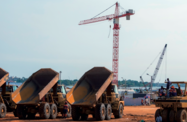Although South Africa’s macroeconomic indicators remain soft, recent data shows that foreign investors are continuing to flow into the country as a public sector-backed infrastructure spending campaign is rolled out.
In its most recent report on the state of the economy, issued on September 9, the South Africa Reserve Bank (SARB) said there had been a rise in foreign direct investment (FDI) in the second quarter, a bright spot in an economy it described as “extremely disappointing given the country’s development needs”.
In early October, the IMF made its fourth cut in a row to South Africa's growth forecast to 1.4% from 1.7%, citing industrial unrest and energy supply constraints. Africa’s second-largest economy narrowly avoided slipping into a recession in the second quarter. Annual GDP growth was just 0.6% in the quarter.
However, FDI reached R24.6bn ($2.2bn) between April and June, more than triple the inflow recorded in the first quarter, according to the bank’s quarterly bulletin. Last year, South Africa rose two places to become the 13th-most attractive foreign direct investment (FDI) destination globally, attracting $10bn in FDI in 2013, according to the A T Kearney FDI confidence index.
Global FDI
The latest figures indicate that South Africa is keeping its status as one of the top destinations for FDI in Africa with the continent as a whole having become the world’s second-most-attractive region for capital investments.
According to an EY report in May, FDI in sub-Saharan Africa increased by 4.7% in 2013 and the region attracted 83% of the continent’s total capital investment inflows. The continent received 5.7% of global foreign direct investments, its highest share in a decade.
While it is no longer Africa’s largest economy – having been surpassed by Nigeria following a GDP re-basing exercise – much of this most recent wave of investment has been coming ashore in South Africa, which has accounted for 24% of all FDI projects over the past seven years, the same as the next three leaders on the EY ladder – Nigeria, Angola and Kenya – put together.
Opportunities
While a large proportion of inbound capital in recent years has flowed into service sectors, such as US-based Wal-Mart’s R16.5bn ($1.5bn) acquisition of Massmart or China’s ICBC $765m purchase of a stake in Standard Bank, South Africa's programme of infrastructure investment has also been a pull for investors, according to a UN report in July. The UN Conference on Trade and Development’s (UNCTAD) World Investment Report for 2014 said FDI flow into eastern and southern Africa in particular was being driven by infrastructure investments and international and regional "market-seeking”.
FDI flows into Southern Africa almost doubled in 2013 to $13bn according to the report, thanks to record-high flows in South Africa and Mozambique.
In recent years the government has made a concerted effort to shore up infrastructure, establishing a handful of large-scale long-term capital investment programmes including the 2012 National Infrastructure Plan (NIP), under which the state plans to spend R4.3trn ($38bn) on new and upgraded infrastructure across the transport, energy, water, sanitation, health and education sectors over a 15-year period.
Major transport projects expected to progress under the NIP include a R16.3bn ($1.47bn) initiative to revitalise the rail network, a R15.2bn ($1.37bn) plan to update and expand provincial bus lines and a variety of other initiatives in the areas of maritime, surface and air transport.
Dumi Jere, head of strategy for Africatalysts, said infrastructure, and particularly utilities development, would continue to attract capital investment into South Africa. “What assisted South Africa’s attractiveness was the independent power programme that the country has launched,” Jere told media in August.
The Renewable Energy Independent Power Producer Procurement Programme (REIPPPP) was initiated in 2011 – one of the core initiatives under the Policy Adjusted Integrated Resource Plan of 2010. So far, 64 projects have been signed, representing foreign and domestic investment of over R100bn ($9.02bn), which will add 3916 MW of renewable energy to South Africa’s energy mix.

